Neolithic
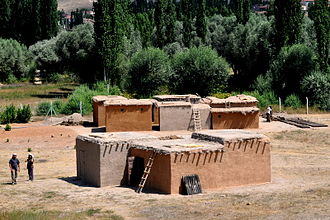 The Neolithic is characterized by fixed human settlements. Reconstruction of Pre-Pottery Neolithic B housing in Aşıklı Höyük, modern Turkey. | |
| Period | Final period of Stone Age |
|---|---|
| Dates | 10,000–4,500 BCE |
| Preceded by | Mesolithic, Epipalaeolithic |
| Followed by | Chalcolithic |
| Part of a series on |
| Human history and prehistory |
|---|
| ↑ before Homo (Pliocene epoch) |
| ↓ Future (Holocene epoch) |
The Neolithic or New Stone Age (from
The Neolithic began about 12,000 years ago when farming appeared in the Epipalaeolithic Near East, and later in other parts of the world. It lasted in the Near East until the transitional period of the Chalcolithic (Copper Age) from about 6,500 years ago (4500 BCE), marked by the development of metallurgy, leading up to the Bronze Age and Iron Age.
In other places, the Neolithic followed the
Origin
Following the
Early Neolithic farming was limited to a narrow range of plants, both wild and domesticated, which included
Not all of these cultural elements characteristic of the Neolithic appeared everywhere in the same order: the earliest farming societies in the Near East did not use pottery. In other parts of the world, such as Africa, South Asia and Southeast Asia, independent domestication events led to their own regionally distinctive Neolithic cultures, which arose completely independently of those in Europe and Southwest Asia. Early Japanese societies and other East Asian cultures used pottery before developing agriculture.[10][11]
Periods by region
Southwest Asia
This section needs additional citations for verification. (August 2015) |
Prehistoric Southwest Asia | ||
Axis scale is years Before Present |
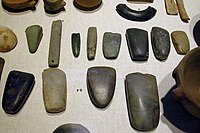
In the Middle East, cultures identified as Neolithic began appearing in the 10th millennium BC.[12] Early development occurred in the Levant (e.g. Pre-Pottery Neolithic A and Pre-Pottery Neolithic B) and from there spread eastwards and westwards. Neolithic cultures are also attested in southeastern Anatolia and northern Mesopotamia by around 8000 BC.[citation needed]
Anatolian Neolithic farmers derived a significant portion of their ancestry from the Anatolian hunter-gatherers (AHG), suggesting that agriculture was adopted in site by these hunter-gatherers and not spread by demic diffusion into the region.[13]
Pre-Pottery Neolithic A
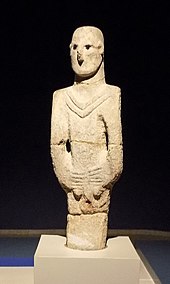
The Neolithic 1 (PPNA) period began roughly around 10,000 BC in the
The major advance of Neolithic 1 was true farming. In the proto-Neolithic
In 2006, remains of figs were discovered in a house in Jericho dated to 9400 BC. The figs are of a mutant variety that cannot be pollinated by insects, and therefore the trees can only reproduce from cuttings. This evidence suggests that figs were the first cultivated crop and mark the invention of the technology of farming. This occurred centuries before the first cultivation of grains.[18]
Settlements became more permanent, with circular houses, much like those of the Natufians, with single rooms. However, these houses were for the first time made of mudbrick. The settlement had a surrounding stone wall and perhaps a stone tower (as in Jericho). The wall served as protection from nearby groups, as protection from floods, or to keep animals penned. Some of the enclosures also suggest grain and meat storage.[19]
Pre-Pottery Neolithic B
The Neolithic 2 (PPNB) began around 8800 BC according to the
Settlements have rectangular mud-brick houses where the family lived together in single or multiple rooms. Burial findings suggest an
Pre-Pottery Neolithic C
Work at the site of
Late Neolithic
The Late Neolithic began around 6,400 BC in the
The Chalcolithic (Stone-Bronze) period began about 4500 BC, then the Bronze Age began about 3500 BC, replacing the Neolithic cultures.[citation needed]
Fertile Crescent
Around 10,000 BC the first fully developed Neolithic cultures belonging to the phase Pre-Pottery Neolithic A (PPNA) appeared in the Fertile Crescent.[12] Around 10,700–9400 BC a settlement was established in Tell Qaramel, 10 miles (16 km) north of Aleppo. The settlement included two temples dating to 9650 BC.[23] Around 9000 BC during the PPNA, one of the world's first towns, Jericho, appeared in the Levant. It was surrounded by a stone wall, may have contained a population of up to 2,000–3,000 people, and contained a massive stone tower.[24] Around 6400 BC the Halaf culture appeared in Syria and Northern Mesopotamia.
In 1981, a team of researchers from the Maison de l'Orient et de la Méditerranée, including Jacques Cauvin and Oliver Aurenche, divided Near East Neolithic chronology into ten periods (0 to 9) based on social, economic and cultural characteristics.[25] In 2002, Danielle Stordeur and Frédéric Abbès advanced this system with a division into five periods.
- Natufianbetween 12,000 and 10,200 BC,
- Sultanian (Jericho), Mureybetian,
- Early PPNB (PPNB ancien) between 8800 and 7600 BC, middle PPNB (PPNB moyen) between 7600 and 6900 BC,
- Late PPNB (PPNB récent) between 7500 and 7000 BC,
- A PPNB (sometimes called PPNC) transitional stage (PPNB final) in which Halaf and dark faced burnished ware begin to emerge between 6900 and 6400 BC.[26]
They also advanced the idea of a transitional stage between the PPNA and PPNB between 8800 and 8600 BC at sites like Jerf el Ahmar and Tell Aswad.[27]
Southern Mesopotamia
Alluvial plains (Sumer/Elam). Low rainfall makes irrigation systems necessary. Ubaid culture from 6,900 BC.[citation needed]
Northeastern Africa
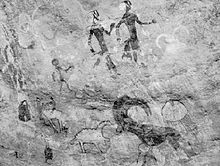
The earliest evidence of Neolithic culture in northeast Africa was found in the archaeological sites of
Northwestern Africa
The neolithization of Northwestern Africa was initiated by Iberian, Levantine (and perhaps Sicilian) migrants around 5500-5300 BC.[36] During the Early Neolithic period, farming was introduced by Europeans and was subsequently adopted by the locals.[36] During the Middle Neolithic period, an influx of ancestry from the Levant appeared in Northwestern Africa, coinciding with the arrival of pastoralism in the region.[36] The earliest evidence for pottery, domestic cereals and animal husbandry is found in Morocco, specifically at Kaf el-Ghar.[36]
Sub-Saharan Africa
The Pastoral Neolithic was a period in Africa's
The Savanna Pastoral Neolithic or SPN (formerly known as the Stone Bowl Culture) is a collection of ancient societies that appeared in the
Europe

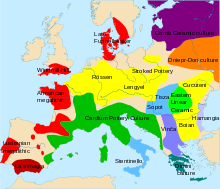
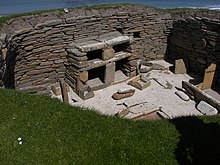
In southeast Europe agrarian societies first appeared in the 7th millennium BC, attested by one of the earliest farming sites of Europe, discovered in Vashtëmi, southeastern Albania and dating back to 6500 BC.[43][44] In most of Western Europe in followed over the next two thousand years, but in some parts of Northwest Europe it is much later, lasting just under 3,000 years from c. 4500 BC–1700 BC. The Neolithic began on the Iberian Peninsula in 5700/5600 cal. BC according to several sites in the Levant area of the Peninsula. On the Northern Iberian Plateau, domestic agrotypes of wheat and barley, ovicaprid livestock, Neolithic pottery, shaped and polished tools are all present in the karst records and the open air sites from the last third of the VI millennium cal. BC.[45][46][47] Recent advances in archaeogenetics have confirmed that the spread of agriculture from the Middle East to Europe was strongly correlated with the migration of early farmers from Anatolia about 9,000 years ago, and was not just a cultural exchange.[48][49]
Anthropomorphic figurines have been found in the Balkans from 6000 BC,
The
With some exceptions, population levels rose rapidly at the beginning of the Neolithic until they reached the carrying capacity.[54] This was followed by a population crash of "enormous magnitude" after 5000 BC, with levels remaining low during the next 1,500 years.[54] Populations began to rise after 3500 BCE, with further dips and rises occurring between 3000 and 2500 BC but varying in date between regions.[54] Around this time is the Neolithic decline, when populations collapsed across most of Europe, possibly caused by climatic conditions, plague, or mass migration.[55]
South and East Asia
Settled life, encompassing the transition from foraging to farming and pastoralism, began in South Asia in the region of Balochistan, Pakistan, around 7,000 BC.[56][57][58] At the site of Mehrgarh, Balochistan, presence can be documented of the domestication of wheat and barley, rapidly followed by that of goats, sheep, and cattle.[59] In April 2006, it was announced in the scientific journal Nature that the oldest (and first Early Neolithic) evidence for the drilling of teeth in vivo (using bow drills and flint tips) was found in Mehrgarh.[60]
In South India, the Neolithic began by 6500 BC and lasted until around 1400 BC when the Megalithic transition period began. South Indian Neolithic is characterized by Ash mounds[clarification needed] from 2500 BC in Karnataka region, expanded later to Tamil Nadu.[61]

In East Asia, the earliest sites include the
The 'Neolithic' (defined in this paragraph as using polished stone implements) remains a living tradition in small and extremely remote and inaccessible pockets of
In 2012, news was released about a new farming site discovered in
The Americas
In
The Formative stage is equivalent to the Neolithic Revolution period in Europe, Asia, and Africa. In the southwestern United States it occurred from 500 to 1200 AD when there was a dramatic increase in population and development of large villages supported by agriculture based on dryland farming of maize, and later, beans, squash, and domesticated turkeys. During this period the bow and arrow and ceramic pottery were also introduced.[68] In later periods cities of considerable size developed, and some metallurgy by 700 BC.[69]
Australia
Australia, in contrast to
Cultural characteristics
Social organization


During most of the Neolithic age of
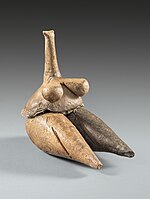
The
Families and households were still largely independent economically, and the household was probably the center of life.
There is a large body of evidence for fortified settlements at Linearbandkeramik sites along the Rhine, as at least some villages were fortified for some time with a palisade and an outer ditch.[82][83] Settlements with palisades and weapon-traumatized bones, such as those found at the Talheim Death Pit, have been discovered and demonstrate that "...systematic violence between groups" and warfare was probably much more common during the Neolithic than in the preceding Paleolithic period.[77] This supplanted an earlier view of the Linear Pottery Culture as living a "peaceful, unfortified lifestyle".[84]
Control of labour and inter-group conflict is characteristic of
Shelter and sedentism
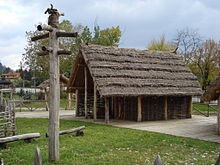
The shelter of the early people changed dramatically from the
Agriculture
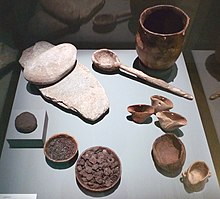
A significant and far-reaching shift in human
The profound differences in human interactions and subsistence methods associated with the onset of early agricultural practices in the Neolithic have been called the
One potential benefit of the development and increasing sophistication of farming technology was the possibility of producing surplus crop yields, in other words, food supplies in excess of the immediate needs of the community. Surpluses could be stored for later use, or possibly traded for other necessities or luxuries. Agricultural life afforded securities that nomadic life could not, and sedentary farming populations grew faster than nomadic.
However, early farmers were also adversely affected in times of famine, such as may be caused by drought or pests. In instances where agriculture had become the predominant way of life, the sensitivity to these shortages could be particularly acute, affecting agrarian populations to an extent that otherwise may not have been routinely experienced by prior hunter-gatherer communities.[79] Nevertheless, agrarian communities generally proved successful, and their growth and the expansion of territory under cultivation continued.
Another significant change undergone by many of these newly agrarian communities was one of diet. Pre-agrarian diets varied by region, season, available local plant and animal resources and degree of pastoralism and hunting. Post-agrarian diet was restricted to a limited package of successfully cultivated cereal grains, plants and to a variable extent domesticated animals and animal products. Supplementation of diet by hunting and gathering was to variable degrees precluded by the increase in population above the carrying capacity of the land and a high sedentary local population concentration. In some cultures, there would have been a significant shift toward increased starch and plant protein. The relative nutritional benefits and drawbacks of these dietary changes and their overall impact on early societal development are still debated.
In addition, increased population density, decreased population mobility, increased continuous proximity to domesticated animals, and continuous occupation of comparatively population-dense sites would have altered sanitation needs and patterns of disease.
Lithic technology
The identifying characteristic of Neolithic technology is the use of polished or ground stone tools, in contrast to the flaked stone tools used during the Paleolithic era.
Neolithic people were skilled farmers, manufacturing a range of tools necessary for the tending, harvesting and processing of crops (such as
Neolithic peoples in the Levant, Anatolia, Syria, northern Mesopotamia and
The peoples of the
Clothing
Most clothing appears to have been made of animal skins, as indicated by finds of large numbers of bone and antler pins that are ideal for fastening leather. Wool cloth and linen might have become available during the later Neolithic,[90][91] as suggested by finds of perforated stones that (depending on size) may have served as spindle whorls or loom weights.[92][93][94]
List of early settlements


| The Stone Age |
|---|
| ↑ before Homo (Pliocene) |
|
| ↓ Chalcolithic |
Neolithic
| name | location | early date (BC) | late date (BC) | comments |
|---|---|---|---|---|
| Tell Qaramel | Syria | 10,700[95] | 9400 | |
| Franchthi Cave | Greece | 10,000 | reoccupied between 7500 and 6000 BC | |
| Göbekli Tepe | Turkey | 9600 | 8000 | |
| Nanzhuangtou | Hebei, China | 9500 | 9000 | |
| Byblos | Lebanon | 8800 | 7000[96] | |
| Jericho (Tell es-Sultan) | West Bank | 9500 | arising from the earlier Epipaleolithic Natufian culture
| |
| Pulli settlement | Estonia | 8500 | 5000 | oldest known settlement of Kunda culture |
| Aşıklı Höyük | Central Anatolia, Turkey , an Aceramic Neolithic period settlement
|
8200 | 7400 | correlating with the E/MPPNB in the Levant |
Nevali Cori
|
Turkey | 8000 | ||
| Bhirrana | India | 7600 | 7200 | Hakra ware |
| Pengtoushan culture | China | 7500 | 6100 | rice residues were carbon-14 dated to 8200–7800 BC |
| Çatalhöyük | Turkey | 7500 | 5700 | |
| Mentesh Tepe and Kamiltepe | Azerbaijan | 7000 | 3000[97] | |
'Ain Ghazal
|
Jordan | 7250 | 5000 | |
| Chogha Bonut | Iran | 7200 | ||
| Jhusi | India | 7100 | ||
| Motza | Israel | 7000 | ||
| Ganj Dareh | Iran | 7000 | ||
| Lahuradewa | India | 7000 [98] | presence of rice cultivation, ceramics etc. | |
| Jiahu | China | 7000 | 5800 | |
| Knossos | Crete | 7000 | ||
| Khirokitia | Cyprus | 7000 | 4000 | |
| Mehrgarh | Pakistan | 7000 | 5500 | aceramic but elaborate culture including mud brick, houses, agriculture etc. |
| Sesklo | Greece | 6850 | with a 660-year margin of error | |
| Horton Plains | Sri Lanka | 6700 | cultivation of oats and barley as early as 11,000 BC | |
| Porodin | North Macedonia | 6500[99] | ||
| Padah-Lin Caves | Burma | 6000 | ||
| Petnica | Serbia | 6000 | ||
| Stara Zagora | Bulgaria | 5500 | ||
Cucuteni-Trypillian culture
|
Ukraine, Moldova and Romania | 5500 | 2750 | |
| Tell Zeidan | northern Syria | 5500 | 4000 | |
Tabon Cave Complex
|
Quezon, Palawan, Philippines | 5000 | 2000[100][101] | |
| Hemudu culture, large-scale rice plantation | China | 5000 | 4500 | |
| The Megalithic Temples of Malta | Malta | 3600 | ||
| Knap of Howar and Skara Brae | Orkney, Scotland | 3500 | 3100 | |
| Brú na Bóinne | Ireland | 3500 | ||
| Lough Gur | Ireland | 3000 | ||
Shengavit Settlement
|
Armenia | 3000 | 2200 | |
Norte Chico civilization , 30 aceramic Neolithic period settlements
|
northern coastal Peru | 3000 | 1700 | |
| Tichit Neolithic village on the Tagant Plateau | central southern Mauritania | 2000 | 500 | |
| Oaxaca, state | Southwestern Mexico | 2000 | by 2000 BC Neolithic sedentary villages had been established in the Central Valleys region of this state. | |
| Lajia | China | 2000 | ||
| Mumun pottery period | Korean Peninsula | 1800 | 1500 | |
| Neolithic revolution | Japan | 500 | 300 |
The world's oldest known engineered
List of cultures and sites
| The Neolithic |
|---|
| ↑ Mesolithic |
| ↓ Chalcolithic |
Note: Dates are very approximate, and are only given for a rough estimate; consult each culture for specific time periods.
Early Neolithic
Periodization: The Levant: 9500–8000 BC;
- Pre-Pottery Neolithic A (Levant, 9500–8000 BC)
- Nanzhuangtou (China, 8500 BC)
- Franchthi Cave (Greece, 7000 BC)
- Cishan culture (China, 6500–5000 BC)
- Sesklo village (Greece, c. 6300 BC)
- Starcevo-Criş culture (Starčevo-Körös-Criş culture)(Balkans, 5800–4500 BC)
- Katundas Cavern (Albania, 6th millennium BC)
- Dudeşti culture(Romania, 6th millennium BC)
- Beixin culture (China, 5300–4100 BC)
- Tamil Nadu culture (India, 3000–2800 BC)[102]
- Mentesh Tepe and Kamiltepe (Azerbaijan, 7000–3000 BC)[97]
Middle Neolithic
Periodization: The Levant: 8000–6500 BC; Europe: 5500–3500 BC; Elsewhere: varies greatly, depending on region.
- Pre-Pottery Neolithic B (Levant, 7600–6000 BC)
- Baodun culture
- Jinsha settlement and Sanxingduimound.
- Çatalhöyük
- Cardium pottery culture
- Comb Ceramic culture
- Corded Wareculture
- Cortaillod culture
- Cucuteni-Trypillian culture
- Dadiwan culture
- Dawenkou culture
- Daxi culture
- Chengtoushan settlement
- Dapenkeng culture (Taiwan, 4000–3000 BC)
- Grooved ware people
- Skara Brae, et al.
- Erlitou culture
- Xia Dynasty
- Ertebølle culture
- Hembury culture
- Hemudu culture
- Hongshan culture
- Houli culture
- Horgen culture
- Kura–Araxes culture
- Liangzhu culture
- Linear Pottery culture
- Circular ditches, et al.
- Longshan culture
- Majiabang culture
- Majiayao culture
- Peiligang culture
- Pengtoushan culture
- Pfyn culture
- Precucuteni culture
- Qujialing culture
- Shijiahe culture
- Trypillian culture
- Vinča culture
- Lengyel culture (Central Europe, 5000–3400 BC)
- Varna culture (South/Eastern Europe 4400–4100 BC)
- Windmill Hill culture
- Xinglongwa culture
- Beifudi site
- Xinle culture
- Yangshao culture
- Zhaobaogou culture
Later Neolithic
Periodization: 6500–4500 BC; Europe: 5000–3000 BC; Elsewhere: varies greatly, depending on region.
- Pottery Neolithic(Fertile Crescent, 6400–4500 BC)
- Halaf culture (Mesopotamia, 6100 BC and 5100 BC)
- Halaf-Ubaid Transitional period (Mesopotamia, 5500–5000 BC)
- Ubaid 1/2 (5400–4500 BC)
- Funnelbeaker culture (North/Eastern Europe, 4300–2800 BC)
- Chalcolithic
Periodization: : varies greatly, depending on region. In the Americas, the Chalcolithic ended as late as the 19th century AD for some peoples.
- Ubaid 3/4 (Mesopotamia, 4500–4000 BC)
- early Uruk period (Mesopotamia, 4000–3800 BC)
- middle Uruk period (Mesopotamia, 3800–3400 BC)
- late Trypillian(Eastern Europe, 3000–2750 BC)
- Gaudo Culture(Italy, 3150–2950 BC)
- Corded Ware culture (North/Eastern Europe, 2900–2350 BC)
- Beaker culture(Central/Western Europe, 2900–1800 BC)
Comparative chronology
See also
References
Citations
- ^ "Neolithic". Oxford English Dictionary (Online ed.). Oxford University Press. (Subscription or participating institution membership required.)
- ^ Karin Sowada and Peter Grave. Egypt in the Eastern Mediterranean during the Old Kingdom.
- ^ Lukas de Blois and R. J. van der Spek. An Introduction to the Ancient World. p. 14.
- ^ "Neolithic Periods Overview". egyptianmuseum.org. Retrieved 2022-04-20.
- ^ Chang, K.C.: "Studies of Shang Archaeology", pp. 6–7, 1. Yale University Press, 1982.
- ^ Encyclopedia Britannica, "Stone Age"
- ^ Cavalli-Sforza, Luigi Luca; Menozzi, Paolo; Piazza, Alberto (1994). The History and Geography of Human Genes. Princeton, NJ: Princeton University Press. p. 351.
at first European contact .... [New Guineans] represented ... modern examples of Neolithic horticulturalists
- ^ Hampton, O. W. (1999). Culture of Stone: Sacred and Profane Uses of Stone Among the Dani. College Station, TX: Texas A&M University Press. p. 6.
- S2CID 13350469.
- ISBN 978-0-521-77670-7.
- ^
Xiaohong Wu (2012). "Early Pottery at 20,000 Years Ago in Xianrendong Cave, China". Science. 336 (6089). Sciencemag.org: 1696–1700. S2CID 37666548. Retrieved 15 January 2015.
- ^ a b c d e Bellwood 2004, p. 384.
- PMID 30890703.
- ISBN 978-3319484020.
- ISBN 978-2271081872.
- ISBN 978-1591438359.
- ^ Scham, Sandra (November 2008). "The World's First Temple". Archaeology. 61 (6). Archaeological Institute of America: 23.
- S2CID 42150441.
- ^ "Neolithic Age". 7 August 2015.
- ^ Feldman, Keffie. "Ain-Ghazal (Jordan) Pre-pottery Neolithic B Period pit of lime plaster human figures". Joukowsky Institute for Archaeology and the Ancient World. Brown University. Retrieved March 9, 2018.
- ^ Zarins, Juris (1992) "Pastoral Nomadism in Arabia: Ethnoarchaeology and the Archaeological Record", in Ofer Bar-Yosef and A. Khazanov, eds. "Pastoralism in the Levant"
- ISBN 978-0199212972.
- ^ Yet another sensational discovery by polish archaeologists in Syria Archived 2011-10-01 at the Wayback Machine. eduskrypt.pl. 21 June 2006
- ^ "Jericho", Encyclopædia Britannica
- ^ Haïdar Boustani, M. "The Neolithic of Lebanon in the context of the Near East: State of knowledge" Archived 2018-11-16 at the Wayback Machine (in French), Annales d'Histoire et d'Archaeologie, Universite Saint-Joseph, Beyrouth, Vol. 12–13, 2001–2002. Retrieved on 2011-12-03.
- ^ Stordeur, Danielle., Abbès Frédéric., "Du PPNA au PPNB: mise en lumière d'une phase de transition à Jerf el Ahmar (Syrie)", Bulletin de la Société préhistorique française, Volume 99, Issue 3, pp. 563–595, 2002
- ^ PPND – the Platform for Neolithic Radiocarbon Dates – Summary. exoriente. Retrieved on 2011-12-03.
- ISBN 9780415757539.
- doi:10.1016/j.jaridenv.2009.04.014. Archived from the original(PDF) on 2022-03-09. Retrieved 2013-09-05.
- ^ Hays, Jeffrey (March 2011). "Early Domesticated Animals". Facts and Details. Archived from the original on 21 October 2013. Retrieved 5 September 2013.
- ISBN 978-1-84142-018-9.
- ISBN 978-0-19-955995-4. Retrieved 3 December 2011.
- ISBN 978-0-19-928308-8.
- ISBN 978-0-306-46755-4. Retrieved 3 December 2011.
- ISBN 978-1-57958-245-6. Retrieved 3 December 2011.
- ^ PMID 37286608.
- S2CID 19466568.
- S2CID 162218030.
- PMID 29370242.
- S2CID 162352311.
- ISBN 978-0520045743. Retrieved 4 December 2014.
- PMID 29902271.
- ^ Dawn Fuller (April 16, 2012). "UC research reveals one of the earliest farming sites in Europe". Phys.org. Retrieved April 18, 2012.
- ^ "One of Earliest Farming Sites in Europe Discovered". ScienceDaily. April 16, 2012. Retrieved April 18, 2012.
- ^ Marcos Saiz, F. Javier (2006). La Sierra de Atapuerca y el Valle del Arlanzón. Patrones de asentamiento prehistóricos. Editorial Dossoles. Burgos, Spain.
- ISBN 9781407315195.
- doi:10.1016/j.quaint.2015.10.002.)
{{cite journal}}: CS1 maint: multiple names: authors list (link - ^ Curry, Andrew (August 2019). "The first Europeans weren't who you might think". National Geographic. Archived from the original on March 19, 2021.
- ^ Spinney, Laura (1 July 2020). "When the First Farmers Arrived in Europe, Inequality Evolved". Scientific American.
- ^ Female figurine, c. 6000 BC, Nea Nikomidia, Macedonia, Veroia, (Archaeological Museum), Greece. Macedonian-heritage.gr. Retrieved on 2011-12-03.
- ^ Winn, Shan (1981). Pre-writing in Southeastern Europe: The Sign System of the Vinča Culture ca. 4000 BC. Calgary: Western Publishers.
- ^ Daniel Cilia, "Malta Before Common Era", in The Megalithic Temples of Malta. Retrieved 28 January 2007.
- ISBN 978-0-9565106-2-4
- ^ a b c Shennan & Edinborough 2007.
- .
- ^ Coningham, Robin; Young, Ruth (2015), The Archaeology of South Asia: From the Indus to Asoka, c. 6500 BCE – 200 CE, Cambridge University Press Quote: ""Mehrgarh remains one of the key sites in South Asia because it has provided the earliest known undisputed evidence for farming and pastoral communities in the region, and its plant and animal material provide clear evidence for the ongoing manipulation, and domestication, of certain species. Perhaps most importantly in a South Asian context, the role played by zebu makes this a distinctive, localised development, with a character completely different to other parts of the world. Finally, the longevity of the site, and its articulation with the neighbouring site of Nausharo (c. 2800–2000 BC), provides a very clear continuity from South Asia's first farming villages to the emergence of its first cities (Jarrige, 1984)."
- ISBN 978-1-107-11162-2Quote: "page 33: "The earliest discovered instance in India of well-established, settled agricultural society is at Mehrgarh in the hills between the Bolan Pass and the Indus plain (today in Pakistan) (see Map 3.1). From as early as 7000 BC, communities there started investing increased labor in preparing the land and selecting, planting, tending, and harvesting particular grain-producing plants. They also domesticated animals, including sheep, goats, pigs, and oxen (both humped zebu [Bos indicus] and unhumped [Bos taurus]). Castrating oxen, for instance, turned them from mainly meat sources into domesticated draft-animals as well."
- ISBN 978-0-19-882905-8, Quote: "(p 29) "The subcontinent's people were hunter-gatherers for many millennia. There were very few of them. Indeed, 10,000 years ago there may only have been a couple of hundred thousand people, living in small, often isolated groups, the descendants of various 'modern' human incomers. Then, perhaps linked to events in Mesopotamia, about 8,500 years ago agriculture emerged in Baluchistan."
- ISBN 978-0-521-57652-9
- S2CID 6787162.
- ^ Eleni Asouti and Dorian Q Fuller (2007). Trees and Woodlands of South India: Archaeological Perspectives.
- PMID 22355109.
- ^ "New Archaeological Discoveries and Researches in 2004 – The Fourth Archaeology Forum of CASS". Institute of Archaeology, Chinese Academy of Social Sciences. April 28, 2005. Retrieved September 18, 2007.
- ^ Liu, Li; Chen, Xingcan (2012), The Archaeology of China: From the Late Paleolithic to the Early Bronze Age, Cambridge University Press, pp. 220, 227, 251
- ^ The Archaeology News Network. 2012. "Neolithic farm field found in South Korea" Archived 2012-11-20 at the Wayback Machine.
- ^ The Korea Times (2012). "East Asia's oldest remains of agricultural field found in Korea".
- ISBN 978-0-226-89888-9.
- S2CID 163007590.
- ^ A. Eichler, G. Gramlich, T. Kellerhals, L. Tobler, Th. Rehren & M. Schwikowski (2017). "Ice-core evidence of earliest extensive copper metallurgy in the Andes 2700 years ago"
- ^ White, Peter, "Revisiting the 'Neolithic Problem' in Australia" PDF, 2006
- ^ ISBN 0-7190-5612-8.
- ISBN 978-0-8058-2210-6. Retrieved 3 December 2011.
- ^ "The Oldest Civilization in the Americas Revealed" (PDF). CharlesMann. Science. Archived from the original (PDF) on 10 October 2015. Retrieved 9 October 2015.
- ^ "First Andes Civilization Explored". BBC News. 22 December 2004. Retrieved 9 October 2015.
- ISBN 978-0-19-991612-2.
- ^ "Stone Age", Microsoft Encarta Online Encyclopedia 2007 © 1997–2007 Microsoft Corporation. All Rights Reserved. Contributed by Kathy Schick, B.A., M.A., Ph.D. and Nicholas Toth, B.A., M.A., Ph.D. Archived 2009-11-01.
- ^ ISBN 978-0-226-31126-5. Retrieved 3 December 2011.
- ^ "Farming Pioneered in Ancient New Guinea". New Scientist. Retrieved 9 October 2015.
- ^ a b Bahn, Paul (1996) "The atlas of world archeology" Copyright 2000 The brown Reference Group plc
- ^ "Prehistoric Cultures". Museum of Ancient and Modern Art. 2010. Archived from the original on 3 August 2018. Retrieved 5 September 2013.
- ^ Hirst, K. Kris. "Çatalhöyük: Urban Life in Neolithic Anatolia". About.com Archaeology. About.com. Archived from the original on 21 October 2013. Retrieved 5 September 2013.
- ^ Idyllic Theory of Goddess Creates Storm Archived 2008-02-19 at the Wayback Machine. Holysmoke.org. Retrieved on 2011-12-03.
- ^ Krause (1998) under External links, places.
- ^ Gimbutas (1991) page 143.
- ISBN 978-0-306-46122-4. Retrieved 3 December 2011.
- ^ Gil Stein, "Economy, Ritual and Power in 'Ubaid Mesopotamia" in Chiefdoms and Early States in the Near East: The Organizational Dynamics of Complexity.
- ^ Timothy Earle, "Property Rights and the Evolution of Chiefdoms" in Chiefdoms: Power, Economy, and Ideology.
- ^ a b Shane, Orrin C. III, and Mine Küçuk. "The World's First City." Archived 2008-03-15 at the Wayback Machine Archaeology 51.2 (1998): 43–47.
- ISBN 978-1-59942-983-0. Retrieved 28 March 2011.
- ^ Harris, Susanna (2009). "Smooth and Cool, or Warm and Soft: Investigating the Properties of Cloth in Prehistory". North European Symposium for Archaeological Textiles X. Academia.edu. Retrieved 5 September 2013.
- ^ "Aspects of Life During the Neolithic Period" (PDF). Teachers' Curriculum Institute. Archived from the original (PDF) on 5 May 2016. Retrieved 5 September 2013.
- ^ Gibbs, Kevin T. (2006). "Pierced clay disks and Late Neolithic textile production". Proceedings of the 5th International Congress on the Archaeology of the Ancient Near East. Academia.org. Retrieved 5 September 2013.
- hdl:10125/17022.
- ^ Cook, M (2007). "The clay loom weight, in: Early Neolithic ritual activity, Bronze Age occupation and medieval activity at Pitlethie Road, Leuchars, Fife". Tayside and Fife Archaeological Journal. 13: 1–23.
- ISBN 978-83-903796-3-0.
- ISBN 978-1-84217-132-5. Retrieved 18 January 2012.
- ^ a b Ostaptchouk, Dr. "Contribution of FTIR to the Characterization of the Raw Material for "Flint" Chipped Stone and for Beads from Mentesh Tepe and Kamiltepe (Azerbaijan). Preliminary Results".
- ISBN 978-1-58909-817-6. Retrieved 4 July 2011.
- ^ Developed Neolithic period, 5500 BC Archived 2011-03-11 at the Wayback Machine. Eliznik.org.uk. Retrieved on 2011-12-03.
- ^ "Manunggul Burial Jar". Virtual Collection of Asian Masterpieces. Retrieved 5 September 2013.
- ^ "Tabon Cave Complex". National Museum of the Philippines. 2011. Archived from the original on 25 February 2021. Retrieved 5 September 2013.
- ^ "Neolithic Culture of Tamil Nadu: an Overview" (PDF).
Sources
- ISBN 978-0-631-20566-1.
- Shennan, Stephen; Edinborough, Kevan (2007). "Prehistoric population history: From the Late Glacial to the Late Neolithic in Central and Northern Europe". Journal of Archaeological Science. 34 (8): 1339–45. .
Further reading
- Pedersen, Hilthart (2008). Die Jüngere Steinzeit Auf Bornholm. GRIN Verlag. ISBN 978-3-638-94559-2.
External links
- Romeo, Nick (Feb. 2015). Embracing Stone Age Couple Found in Greek Cave. "Rare double burials discovered at one of the largest Neolithic burial sites in Europe." National Geographic Society
- McNamara, John (2005). "Neolithic Period". World Museum of Man. Archived from the original on 2008-04-30. Retrieved 2008-04-14.
- Affonso, T.; Pernicka, E. (2000). "Pre-Pottery Neolithic Clay Figurines from Nevali Çori". Internet Archaeology (9). doi:10.11141/ia.9.4.
- . Encyclopædia Britannica (11th ed.). 1911.
